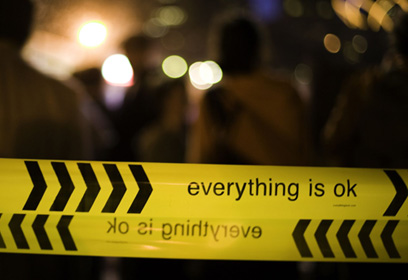The System Worked is a smart, thoughtful, and important book that I largely disagree with. Daniel Drezner, a professor of International Politics at Tufts University and notable public intellectual (he wrote a pioneering and widely admired blog for Foreign Policy and now writes for the Washington Post), has crafted a cogent, counterintuitive interpretation of the global financial crisis. The argument is neatly summed up by the book’s title, and on its first page: “The punch line of this book is that the conventional wisdom is wrong. In response to the 2008 financial crisis . . . global economic governance responded in an effective and nimble fashion. In short, the system worked.”
There is much to agree with in this claim: however bitter the experience of our lingering economic malaise—the “great recession”—the world did indeed avoid another Great Depression. Another such cataclysmic meltdown could have easily taken place in the wake of the financial crisis, as many analysts at the time feared. Drezner disarmingly notes that he was among the pessimists in those dark hours. He positions the book as his explanation of why he was wrong then and why, unlike many more conventional analysts, he is more sanguine now.
Drezner is right: the roof did not fall in, global economic performance stabilized, and, in many quarters, bounced back. But Drezner glances away from an elephant in the room: the system worked much better for some than for others. Speaking of elephants, one reason Drezner reaches conclusions different than those commonly found on the bookshelves sagging with crisis postmortems is that he is grasping firmly at the belly of the beast. There was “the system” before, during, and after the crisis, and it was in the heat of the moment that the system was at its best. But that same system arguably caused the financial crisis and, left largely in place, might yet contribute to another. As Peter Temin and David Vines argue in their book The Leaderless Economy: Why the World Economic System Fell Apart and How to Fix It (2013), while “the initial policy response to the crisis by world leaders” did the crucial job of preventing “a collapse of the world economy,” international cooperation is still wanting. Nevertheless, to have avoided that meltdown was no small thing, and it was the result of good (or, at the very least, non-terrible) public policy. The System Worked attributes this outcome to the performance of international institutions. Drezner has in mind here the “set of formal and informal rules that regulate the global economy,” and he highlights the roles of the International Monetary Fund (IMF), World Trade Organization (WTO), The Bank for International Settlements, and the “G” country meeting groups (first the G7, now the G20). Drezner does not shy away from acknowledging the flaws and limitations of these institutions, and his central thesis, “the system worked better than is commonly believed,” cannot be dismissed as cheerleading.
To be sure, the bar is set fairly low—anything short of utter collapse is coded as the system “working.” Still, the world economy did not in fact collapse, an achievement The System Worked attributes to the influences of interest, power, and ideas.
Compared with the Great Depression, powerful actors with interests in maintaining an open international system were successful in fending off would-be protectionists, indeed with the able assistance of outfits like the WTO. This is no small thing: during the Depression self-imposed protectionism proved self-defeating.
Drezner also emphasizes that continued U.S. predominance helped to hold the system together. Moreover, China was constructive, behaving like a “supporter” rather than a “spoiler.” My own view is that the global financial crisis will come to be seen as an inflection point in world politics. American power and influence have been in decline, and China saw itself as a hostage to the failing system. Both of these dynamics hint at future trouble for that system. But Drezner makes a strong case for the salutary effects of American power and Chinese policy.
Ideas were perhaps even more important than power and interest. According to Drezner, the ideas that were in place before the crisis saw us through and continue “to act as a guide for key actors in the post-crisis world.” And it is easy to nod along, noting with approval the endurance of the ideology of free trade, for instance. But the persistence of ideas is a double-edged sword, as when Drezner notes that financial liberalization remains “a goal of economic governance.” This is a key paradox of the book: if pre-crisis economic ideologies have persisted—and in many quarters of the world, especially the United States, they have—and those ideas contributed to the crisis, then failure to reassess them is not an example of the system “working.”
Drezner weaves through a wealth of evidence to show that a second Great Depression was avoided “because global economic governance functioned properly to maintain economic openness and build resiliency into the system.” My own dissent from this conclusion is rooted in three divergences from his central claims. Yes, the worst was avoided, but this was not a result of the routinized behavior of international institutions. Rather, the ad hoc experiments of individual states did the job. Yes, in many quarters, and especially after the initial terror receded, the ideological attachment to neoliberalism persisted. But this makes the system more vulnerable to future crisis, not less. Because, yes, institutional reforms can be observed, but, given the persistence of economic ideas held by those who wield the power behind these thrones, those reforms are cosmetic and inconsequential.
Did international institutions matter? The WTO—probably. The IMF? The G20? Not so much. The IMF, whose actions exacerbated the 1997–98 Asian Financial Crisis, was in the years leading up to the global crisis asleep at the switch. Actually, it was worse than that. The IMF, like former Federal Reserve Chairman Alan Greenspan, aggressively promoted the policies that precipitated the crisis. At the low point of its power and legitimacy, the IMF then played a marginal role in containing the crisis. As for the G20, Drezner notes that “the pledges made at these summits” were extraordinarily modest and thus easy to fulfill. Was this cooperation and governance—altering policies and following rules in the expectation that others will do the same—or simply harmony—agreeing to do what you already wanted to do? Drezner notes favorably one analyst’s observation that “central banks are simply doing what they are meant to do . . . set monetary policy consistent with their domestic mandates.”
What, then, accounts for the relative success of public policy? Drezner argues persuasively that the Federal Reserve’s decision to make prodigious currency swaps available to European financial institutions—that is, to provide emergency credit to foreign central banks—was crucial. This assessment is shared by many, including Eric Helleiner in his new book The Status Quo Crisis: Global Financial Governance After the 2008 Financial Meltdown. Helleiner also views the “large-scale lending by the U.S. Federal Reserve to foreign central banks” as crucial in containing the crisis and far more significant than any actions taken by the IMF or the G20. Similarly, Drezner notes correctly that without the Troubled Asset Relief Program (TARP), the massive U.S. government bailout of the banks, the crisis would have been much worse. But both of these remedies were improvisations. Ad hoc emergency measures trumped international institutions.
But if international institutions didn’t matter greatly, what prevented a repeat of the dismal policies that made the Great Depression great? As Drezner points out, internationally oriented economic interests are more influential now. Also not to be overlooked is the vastly different state of international politics during the crisis: the intense security dilemma of the interwar years contrasts with the relatively benign great power environment of 2007–8, one reason why the financial crisis of 1931 spiraled out of control while the more recent crisis was contained.
Most of all, policymakers learned from the mistakes of their predecessors, which served as neon-lit warning signs of exactly what not to do. The ghost of Smoot-Hawley past—the signature U.S. policy of Depression-era protectionism—loomed larger in policy debates than did calls for protectionism itself. Back then, the Federal Reserve and the do-nothing liquidationists of the Hoover administration allowed the economy to asphyxiate. This time the fed chair was Ben Bernanke, who made his academic reputation studying those blunders, and the economy was flooded with emergency liquidity. In the interwar years, the United States was tight-fisted, reluctant to lend money abroad. This time it stepped up as the international lender of last resort. And in the early stages of the crisis, most countries wisely moved to stimulate their economies, whereas during the Depression, pre-Keynesian witch doctors prescribed the moral equivalent of leeches and bloodletting.
This welcome result, however, should not be confused with a happy ending. Even though the right emergency medicine was dispensed this time, the health of the financial system remains dismal, and the risk of future illness is ongoing. This scenario is pretty much the opposite of the one that prevailed in the 1930s. Then, when disease swept through the neighborhood, the doctors’ treatments made the sick sicker. But eventually, governments recognized that the neighborhoods were dangerous and had to be redesigned to assure safety from future outbreaks. This time the doctors prevented a deadly epidemic from spreading out of control—and then escorted the inhabitants back into the rickety tenements that bred the disease in the first place. As Anat Admati and Martin Hellwig conclude in The Bankers’ New Clothes: What’s Wrong with Banking and What to Do about It (2013), “The problem posed by some big banks being regarded as too big to fail is greater today than it was in 2008.”
The right emergency medicine was dispensed, but the health of the financial system remains dismal.
Why? Because the bankers dominate their regulators and don’t want to pay for needed fixes. And, ironically, since the crisis was contained short of a complete meltdown, a critical mass of the public has resumed its unwarranted complacency. As former British Prime Minister and Chancellor of the Exchequer Gordon Brown wrote in 2013, “In short, precisely what world leaders sought to avoid—a global financial free-for-all, enabled by ad hoc, unilateral actions—is what has happened. Political expediency, a failure to think and act globally, and a lack of courage to take on vested interests are pushing us inexorably toward the next crash.”
These perspectives contrast with the one offered by The System Worked, which argues that international organizations emerged from the crisis empowered and more capacious. Drezner emphasizes reforms at the IMF and the World Bank and revamped rules and membership opportunities at other organizations. He spends considerable time on the Bank of International Settlements and especially the financial reforms known as Basel III. For Drezner, Basel III is evidence of significant change. It illustrates the “limited influence” of the banks and their reduced ability to get what they want, debunking the “regulatory capture” argument—that the financial industry is pulling the strings of its would-be overseers.
As always, Drezner looks carefully at competing evidence, and his arguments are reasoned and thoughtful. But it is possible to look at the same outcomes and reach opposed conclusions. Drezner notes, for example, that a number of more ambitious reforms, not to mention “more radical proposals—such as a tax on international financial transactions . . . fell by the wayside,” suggesting that wise reforms were introduced, while imprudent proposals were weeded out. But a tiny tax on financial transactions, on the order of one tenth of one percent, is not radical at all. The Tobin tax, named for James Tobin, the Nobel laureate who first proposed it in 1972, is a modest, market-friendly measure that would create small disincentives for destabilizing speculation. Its minimal costs would be borne entirely by a privileged few who choose to engage in socially ruinous financial scheming. An unambiguously good thing, it would register at the margins of the balance sheets of banks gaining fees for churning speculative transitions, just as wise public safety regulations about the handling of radioactive waste show up as a cost borne by the nuclear power industry.
As for Basel III in particular, Admati and Hellwig characterize it as a “flawed approach” that represents “hardly any change.” InGuardians of Finance: Making Regulators Work for Us (2012), James Barth, Gerard Caprio Jr., and Ross Levine assess that Basel III does “not address the fundamental weakness” in the system. Financial Times columnist Martin Wolf summarized Basel III as “The Mouse that Did Not Roar,” arguing that it “will fail to deliver” a “safer banking industry.” But even those rules were too much for finance to bear. In January the FT reported that the rules had been watered down following “ferocious industry lobbying.” An analyst at the investment firm Exane BNP Paribas called it “more of a win for the industry than I was expecting.”
It is systemic reform that will determine the risk of future crisis. And it is on this point that Helleiner and Drezner part company. In The Status Quo Crisis, Helleiner writes, “Expectations of major transformation in global financial governance did not pan out.” Instead he sees regulatory reforms that look “remarkably tame.” The IMF’s reputation is in tatters, its role reduced. The G20 encourages countries to do what they already wanted to do. The Financial Stability Board, touted by former U.S. Treasury Secretary Timothy Geithner as a new and foundational pillar of global economic governance, is, in Helleiner’s estimation, “a remarkably toothless organization.” Meanwhile, “Financial institutions continued to shape outcomes through well-organized and well-financed lobbying.” Looking back at emergency measures taken to save the banks, he concludes, “The public bailouts and support were not used to confront their power, but rather to socialize their losses.”
It is hard to argue with that assessment. Thus, even though Drezner is right that the recession could have easily been the Great Depression 2.0, and the escape from this outcome means something important went right, his formulation omits much that went wrong. The global financial crisis caused the great recession, and aspects of “the system” that underlie the crisis persist. Former Federal Reserve Vice Chairman Alan Blinder warns that proposed reforms must be seen through; we should not forget, he says, that “it was shameful business practices, coupled with regulatory neglect, that got us into this mess.” For Helleiner, if the status quo endures, “it is a virtual certainty that the global financial system would experience further global financial crises, with all their tremendous economic and social costs.”
Those social costs, it must be remembered, are not shared evenly. To the extent that the system worked, it did better for some than for others. Compare, for example, corporate earnings and stock market returns with median household income and employment levels. “The costs of the crisis include millions of unemployed and tens of trillions of dollars in lost output,” Wolf observes. “Governments rescued the financial system,” the only industry “with limitless access to the public purse and . . . by far the most subsidized in the world.” It is frustrating to many that few in the industry look these facts in the eye.
Because of this divergence of experience—and the willful myopia of many with vested interests in the financial sector—The System Worked will be routinely, if casually, invoked by those disposed to agree with its implications; that is, those who are content with the way the global economy currently operates. But Drezner has put forward an argument to be reckoned with, and it is more important that the book find an audience among those who disagree with its conclusions.
The stakes, after all, are very high. In May IMF Managing Director Christine Lagarde warned, “The industry still prizes short-term profit over long term prudence” and noted that massive banks remain “major sources of systemic risk.” This is dismaying, but it should not be surprising. It is a historical regularity that the financial system, left unsupervised, will lead to ruin. In 2000 I wrote a screenplay called “Lender of Last Resort,” about a too-big-to-fail financial outfit that fakes its own bankruptcy in order to provoke a financial crisis and force the government to provide a massive bailout lest an uncontained financial crisis destroy the economy. (It seemed so creative at the time.) That is not what happed in 2007–8—the financial sector delivered a crisis that truly did threaten a complete meltdown of the economy—but the outcome was similar.
High finance, drunk on systemic risk, drove its Maserati ever more recklessly until it inevitably crashed, totaling the real economy. Inside the car, the seat belts held and the airbags deployed. Emergency crews rushed to the scene. Climbing from the wreck, finance dusted itself off and expressed regret about the unforeseeable accident. Its government-sponsored no-fault insurance promptly provided a shiny new replacement. As public officials tossed over the keys, they gently asked if a bit more care might be taken on the roads, a request barely audible over the sound of screeching tires. The system worked especially well—for some.








